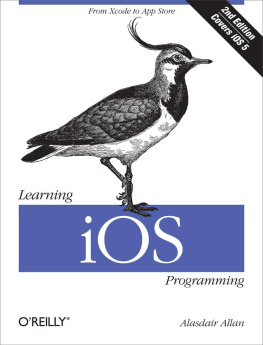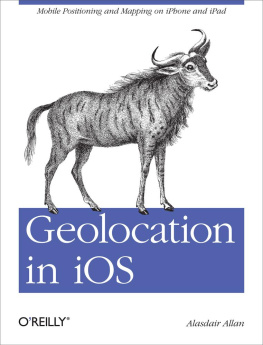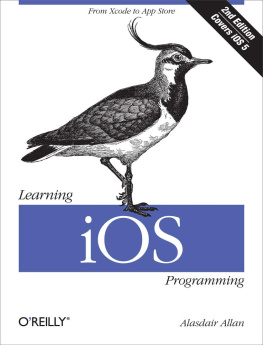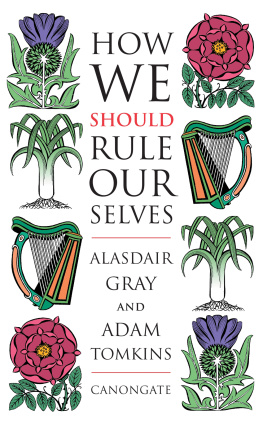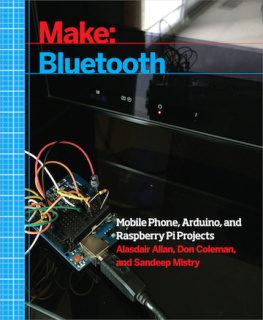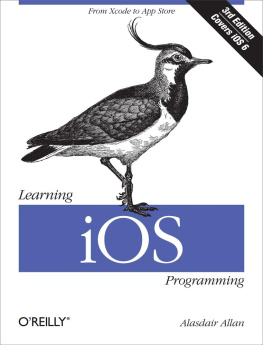Alasdair Allan - Learning iOS Programming
Here you can read online Alasdair Allan - Learning iOS Programming full text of the book (entire story) in english for free. Download pdf and epub, get meaning, cover and reviews about this ebook. year: 2012, publisher: OReilly, genre: Computer. Description of the work, (preface) as well as reviews are available. Best literature library LitArk.com created for fans of good reading and offers a wide selection of genres:
Romance novel
Science fiction
Adventure
Detective
Science
History
Home and family
Prose
Art
Politics
Computer
Non-fiction
Religion
Business
Children
Humor
Choose a favorite category and find really read worthwhile books. Enjoy immersion in the world of imagination, feel the emotions of the characters or learn something new for yourself, make an fascinating discovery.
- Book:Learning iOS Programming
- Author:
- Publisher:OReilly
- Genre:
- Year:2012
- Rating:3 / 5
- Favourites:Add to favourites
- Your mark:
- 60
- 1
- 2
- 3
- 4
- 5
Learning iOS Programming: summary, description and annotation
We offer to read an annotation, description, summary or preface (depends on what the author of the book "Learning iOS Programming" wrote himself). If you haven't found the necessary information about the book — write in the comments, we will try to find it.
Learning iOS Programming — read online for free the complete book (whole text) full work
Below is the text of the book, divided by pages. System saving the place of the last page read, allows you to conveniently read the book "Learning iOS Programming" online for free, without having to search again every time where you left off. Put a bookmark, and you can go to the page where you finished reading at any time.
Font size:
Interval:
Bookmark:
Copyright 2012 Alasdair Allan
OReilly books may be purchased for educational, business, or sales promotional use. Online editions are also available for most titles (.
Nutshell Handbook, the Nutshell Handbook logo, and the OReilly logo are registered trademarks of OReilly Media, Inc. Learning iOS Programming , the image of a lapwing, and related trade dress are trademarks of OReilly Media, Inc.
Many of the designations used by manufacturers and sellers to distinguish their products are claimed as trademarks. Where those designations appear in this book, and OReilly Media, Inc., was aware of a trademark claim, the designations have been printed in caps or initial caps.
While every precaution has been taken in the preparation of this book, the publisher and authors assume no responsibility for errors or omissions, or for damages resulting from the use of the information contained herein.

Supplemental files and examples for this book can be found at http://examples.oreilly.com/0636920018490/. Please use a standard desktop web browser to access these files, as they may not be accessible from all ereader devices.
All code files or examples referenced in the book will be available online. For physical books that ship with an accompanying disc, whenever possible, weve posted all CD/DVD content. Note that while we provide as much of the media content as we are able via free download, we are sometimes limited by licensing restrictions. Please direct any questions or concerns to .
The arrival of the iPhone changed everything. Or, at the very least, it changed the direction of software development for mobile platforms, which is a pretty big thing. It has spawned an entire generation of copycat devices and brought an entire multibillion-dollar industry to its knees. Despite this, it still fits in your pocket.
Despite the title change to Learning iOS Programming , the book you hold in your hands is the second edition of Learning iPhone Programming , although there have been sweeping changes along the way. While the iPhone is just four years old, to me that sometimes seems like a lifetime.
The changes made in this second edition reflect the fact that a lot has happened since the first edition was published: the release of the iPad, a major release of Xcode, two revisions of the operating system itself, and the arrival of Apples iCloud. This book has therefore been refreshed, renewed, and updated to reflect these fairly fundamental changes to the platform, and all of the example code was rewritten from the ground up for Xcode 4 and iOS 5 using ARC.
This book gives a rapid introduction to programming for the iPhone, iPod touch, and iPad for those with some programming experience. If you are developing on the Mac for the first time, drawn to the platform because of the iPhone, or alternatively are an experienced Mac programmer making the transition to the iOS, this book is for you.
The book assumes some knowledge of C, or at least passing knowledge of a C-derived language. Additionally, while I do give a crash course, some familiarity with object-oriented programming concepts would be helpful.
This book will guide you through developing your first application for the iOS from opening Xcode for the first time to submitting your application to the App Store. Youll learn about Objective-C and the core frameworks needed to develop for the iOS by writing applications that use them, giving you a basic framework for building your own applications independently.
Heres a short summary of the chapters in this book and what youll find inside:
This chapter discusses the need for native applications and compares building native applications to building web applications.
This chapter walks you through the process of registering as an iOS developer and setting up your work environment, from installing Xcode and the iOS SDK to generating the developer certificates youll need to build your applications and deploy them onto your own iPhone, iPod touch, or iPad.
This chapter allows you to get hands-on as quickly as possible and walks you through building your first Hello World application, including how to deploy and run the application on your iPhone, iPod touch, or iPad.
This chapter provides a crash course in the basics of the Objective-C language, and if youre familiar with another C-derived language (and perhaps with object-oriented programming), it should be enough to get you up and running with Objective-C and the Cocoa Touch frameworks.
The UITableView and associated classes are perhaps the most commonly used classes when building user interfaces for iOS applications. Due to the nature of the applications, these classes can be used to solve a large cross section of problems, and as a result, they appear almost everywhere. In this chapter, we dive fairly deeply into the table view classes.
After discussing the table view controller in detail, we discuss some of the other view controllers and classes that will become useful when building your applications: simple two-screen views, single-screen tabbed views, modal view controllers, and a view controller for selecting video and images.
This chapter discusses connecting to the Internet, browsing the Web, sending email, and retrieving information.
This chapter discusses how to handle data input, both from the application user and programmatically, and how to parse XML and JSON documents. The chapter also covers storing data in flat files and storing data with the SQLite database engine.
This chapter discusses how to determine what hardware is available and illustrates how to deal with the major sensors on iOS devices: the accelerometer, magnetometer, camera, and GPS.
This chapter walks you through the process of building applications that make use of the Core Location and MapKit frameworks.
This chapter provides a brief introduction to integrating Apples iCloud service into your own applications. iCloud is a service that helps you synchronize your data across devices, making documents and data available to all of your subscribed devices.
This chapter shows you some of the tricks to integrate your application with iOSs software ecosystem, how to present user preferences with Settings Bundles, and how to use custom URL schemes to launch your application. It also discusses how to make use of the Media Player and Address Book.
This chapter talks about how to add some final polish to your application and walks you through the process of building your application for distribution, either via ad hoc distribution or for the App Store.
This chapter provides a collection of pointers to more advanced material on the topics we covered in the book, as well as material covering some of those topics that we didnt manage to talk about in the book.
The following typographical conventions are used in this book:
Indicates new terms, URLs, email addresses, filenames, and file extensions
Font size:
Interval:
Bookmark:
Similar books «Learning iOS Programming»
Look at similar books to Learning iOS Programming. We have selected literature similar in name and meaning in the hope of providing readers with more options to find new, interesting, not yet read works.
Discussion, reviews of the book Learning iOS Programming and just readers' own opinions. Leave your comments, write what you think about the work, its meaning or the main characters. Specify what exactly you liked and what you didn't like, and why you think so.

